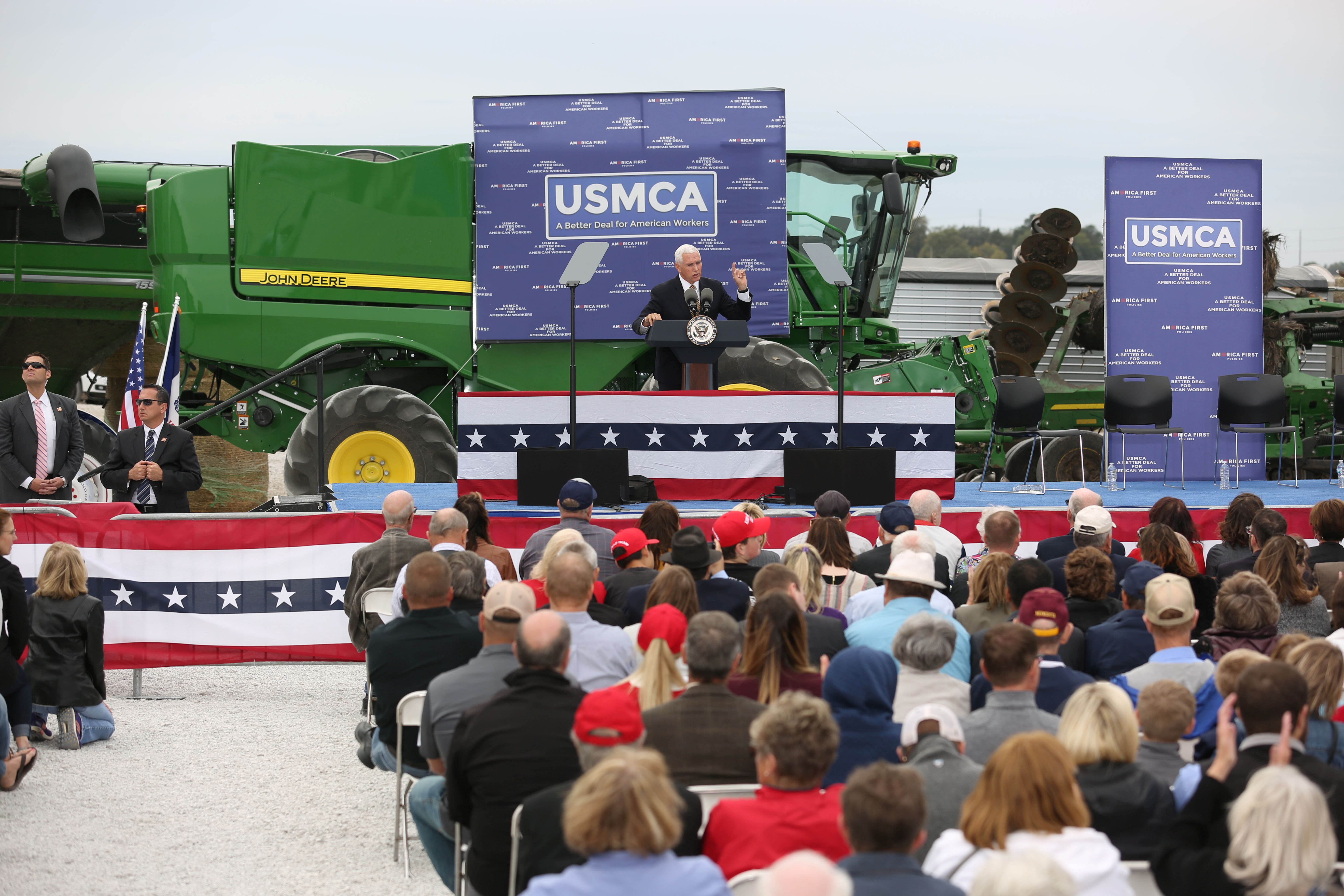USMCA: Less Free Trade, More Regulations

Updated NAFTA
For the most part, the USMCA is a continuation of the North American Free Trade Agreement (NAFTA) from 1994, which removed tariffs on trade between the United States, Canada and Mexico. U.S. President Barack Obama spoke about the need to update this agreement, raising the issues of the flow of digital data and services as well as environmental protection. His administration achieved this by negotiating a much broader agreement, called the Trans-Pacific Partnership (TPP) with Mexico, Canada and nine other countries (for example Japan and Australia). However, in January 2017, immediately after assuming office as president, Donald Trump withdrew the U.S. from the TPP. Among other factors, this forced the three countries to return to the negotiating table. In the end, the USMCA included many of the issues that were identified in the TPP, including e-commerce, data flow, intellectual property protection, streamlining rules of origin and greater market access for providers of dairy products.
The Trump Administration wanted to reduce the trade deficit with both partners, which reached $139 billion in 2019 (see Figure 1). Important changes to NAFTA and the rules negotiated in the TPP that are aimed at that problem concern the automotive sector. The USMCA tightens the rules of origin allowing the tariff-free import of products. At least 75% of the value of a vehicle, as well as 70% of the steel used to make it, must come from the parties to the agreement. In addition, at least 40–45% of the value of a car is to be produced by employees earning at least $16 per hour. A mechanism has also been put in place for expert control of the implementation of the labour provisions by Mexico. The aim of these regulations was to reduce Mexico’s competitiveness and reduce imports of low-cost parts from outside the USMCA area.
In addition, Canada has agreed to increase the import quota for dairy products to 3.6% of the value of the Canadian market (in the TPP it had already committed to 3.25%). Copyright protection has been extended from 50 to 70 years. At the same time a sunset clause has been adopted on termination of the agreement. The USMCA is to be reviewed every six years and there will be automatic termination after 16 years in the absence of the will to extend it. At the request of the United States, the USMCA also includes provisions governing the conclusion of agreements with non-market economies (primarily China) in order to limit potential competition.
Concessions in the Face of U.S. Threats
Although the changes to NAFTA and the TPP are not significant, these concessions would not have been achieved had it not been for the threats made by the U.S. against its partners. In addition to repeatedly announcing the termination of NAFTA during the negotiations, Trump also imposed tariffs on steel and aluminium, and prepared to impose tariffs on imported cars. In this way, he increased the pressure on partners who had less room for manoeuvre due to asymmetry in their trade relations. For Canada, the U.S. is the most important destination for merchandise exports, reaching 75% share of its exports (see Figure 2). In terms of imports, the U.S. plays a smaller role (51%). For Mexico, the U.S. is an even more important market (77% of exports and 47% of imports). For the United States, both countries are less important, with a combined share of exports of 34% (18% goes to Canada and 16% to Mexico). The ratio of foreign trade to GDP is also significantly higher in Canada and Mexico than in the U.S. (66%, 80% and 27%, respectively).
The imposition of tariffs on steel and aluminium, and the prospect of introducing tariffs on cars, meant that Canada and Mexico fought not for additional trade preferences, but above all for the restoration of the status quo, meaning the abolition of tariffs and protection against possible further barriers. It was also important for Canada to maintain the dispute settlement mechanism within the USMCA and to relax the termination clause, the final draft of which gives greater security to maintain the agreement (16 years rather than five, as the U.S. demanded during the talks).
The USMCA in the Shadow of the Pandemic
The agreement with Mexico and Canada was supposed to be one of Trump’s most important economic and negotiating achievements. However, as a result of the COVID-19 pandemic recession, this message does not play an important role in this year’s presidential campaign. The implementation of the agreement itself will also face difficulties as the economic crisis puts pressure on all players, including governments, businesses and consumers. As demand declines, the effects of the agreement will also be more difficult to observe. The expected wage growth in Mexico might also be slower.
The pandemic, on the other hand, will help achieve one of the United States’ objectives of bringing production to the U.S. or North America. Paradoxically, tightening the rules of origin in the USMCA could have had the opposite effect, as the cost of implementing it would reduce the competitiveness of North American markets. Car manufacturers from outside the region, e.g. from the EU or Japan, have access to the U.S. market after paying low tariffs of 2.5% and without having to meet the wage or origin criteria. As a result of the pandemic, however, the security of the global supply chains has been undermined, particularly concerning imports from China. The need to diversify contractors and ramp up storage capacities will increase the costs of maintaining long value chains and thereby support the regionalisation of production close to the final consumer markets.
Conclusions
The agreement is an important political success for Trump, who called NAFTA the worst ever deal. However, for most companies from Mexico, Canada and the United States the main achievement of the USMCA negotiations is the simple preservation of the free trade zone. Trump has been announcing the possibility of terminating NAFTA since 2017. This would mean losing mutual tariff preferences and creating chaos for supply chains in three interconnected markets. The entry into force of the agreement ends this period of uncertainty, thus decreasing the risks for investors in manufacturing facilities in Mexico and Canada, and for importers from these markets. However, despite the USMCA, the stability of the relationship is not guaranteed. Just before the agreement came into force, Trump issued a new threat to impose tariffs on Canadian-imported aluminium (to protect U.S. producers). And, in 2019, he threatened Mexico with new tariffs (to put pressure on that country to curb migration to the U.S.).
The content of the agreement indicates that the U.S. is seeking to improve its trade balance by selectively increasing regulation in trade with partners. Bipartisan support in Congress for the ratification of the agreement shows that, even if the president changes, many trade policy goals will remain the same. On the basis of the USMCA, the EU might identify joint interests as it is also committed to raising standards. It would be beneficial to negotiate joint solutions for rules of origin and protection of workers and the environment. However, there are many roadblocks ahead of any trade negotiations between the U.S. and the EU. Major controversies remain in terms of access to European agri-food markets and the EU’s trade surplus with the United States. The U.S. would also try to require information on negotiations on possible trade or investment agreements with China as a non-market economy. Climate protection would derail any talks with the Trump Administration.
The agreement will not have a negative impact on EU exports to North America, as the USMCA primarily duplicates the existing NAFTA rules. The EU has free trade agreements with Mexico and Canada, guaranteeing preferential access to their consumer markets. The complicated and costly implementation of the USMCA rule of origin may impose higher costs on Mexican manufacturers wishing to export to the U.S. without customs duties. This could be beneficial for European Union exporters.


